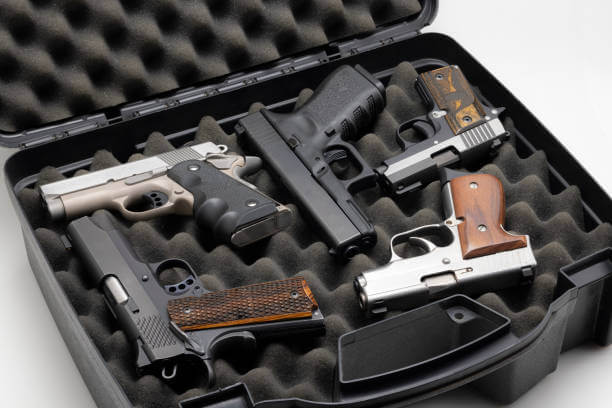Guidelines for Traveling with Firearms in Your Personal Airplane | General Aviation Aircraft
Traveling with firearms in general aviation aircraft combines the freedom of flight with personal rights. However, it demands strict adherence to federal, state, and international laws. At E3 Aviation, we aim to empower pilots with clear, accurate guidance. This comprehensive guide ensures you can exercise your constitutional right to bear arms safely and legally while flying. Let’s explore the regulations, safety tips, and best practices for a seamless journey.
Understanding Federal Regulations for Traveling with Firearms in General Aviation Aircraft
Firstly, the U.S. Bureau of Alcohol, Tobacco, Firearms, and Explosives (ATF) governs firearm transportation. For example, the Gun Control Act regulates sales and possession, while the National Firearms Act covers specific weapons like silencers. Additionally, importing or exporting firearms requires licensed channels, per ATF rules. Compliance is non-negotiable for general aviation pilots. Visit the ATF website for detailed requirements.
Navigating State and Local Laws
Beyond federal rules, state laws vary widely. For instance, federal law applies in “sterile” airport areas, but state laws govern outside these zones. Therefore, check local regulations before landing with firearms. Moreover, concealed carry permit reciprocity differs across states. Contact airport management or law enforcement for approval, as outlined in E3 Aviation’s State-Specific Firearm Laws guide.
Leveraging the Federal Safe Passage Act
Furthermore, the Federal Safe Passage Act (18 U.S.C. § 926A) supports interstate travel. Specifically, it allows lawful firearm transport between states where possession is legal. However, firearms must be unloaded and inaccessible during flight. This means locking them in a hard-sided case, separate from the cockpit. Consequently, pilots enjoy flexibility without legal risks. Learn more at Federal Safe Passage Act.
Proper Storage and Safety Protocols
Additionally, safety is paramount when traveling with firearms in general aviation aircraft. Always unload firearms and store them securely. For example, use a locked container inaccessible from the passenger area. Meanwhile, ensure compliance with TSA guidelines if departing from commercial airports. This aligns with E3 Aviation’s commitment to aviation safety tips.
Handling Ammunition in Flight
Moreover, Title 49 CFR governs ammunition as a hazardous material. Specifically, it requires secure packaging and labeling. However, buying ammunition at your destination simplifies compliance. If transporting, limit quantities to personal use, typically under 11 pounds, per FAA suggestions. Check Title 49 CFR for specifics.
Firearms as Survival Gear
Also, firearms in survival kits follow the same rules. However, signaling devices like flares fall under DOT hazardous material regulations. Therefore, distinguish between these items for proper storage. This ensures preparedness without violating laws, a topic covered in E3 Aviation’s emergency preparedness guide.
International Travel Considerations
For international flights, regulations tighten significantly. For Canada, secure a Non-Resident Firearms Declaration via the Royal Canadian Mounted Police. Visit their RCMP resource for details. Conversely, Mexico discourages firearm entry due to strict laws. Always consult the destination’s embassy or consulate beforehand.
Importing Purchased Firearms
Additionally, firearms bought abroad need ATF registration before U.S. entry. Use licensed importers and declare them to U.S. Customs Service. This process avoids penalties and ensures compliance. The ATF provides guidance on necessary paperwork.
Foreign Nationals and U.S. Regulations
Furthermore, foreign nationals, including nonimmigrant aliens, face restrictions. Generally, they’re prohibited from possessing firearms unless specific exceptions apply. Declare firearms to U.S. Customs upon arrival, per CBP guidelines. This ensures legal travel within the U.S.
Practical Tips for Pilots
Meanwhile, preparation enhances safety and compliance. Firstly, verify firearm and ammunition weight for aircraft balance. Secondly, document permits and approvals. Thirdly, notify the pilot-in-command if others are aboard. These steps align with E3 Aviation’s pilot checklist.
Table of Key Regulations
| Regulation | Description | Source |
|---|---|---|
| Gun Control Act (GCA) | Regulates commercial sale, transfer, and possession of firearms | ATF Website |
| National Firearms Act (NFA) | Covers possession and transfer of dangerous firearms like machine guns | ATF Website |
| Federal Safe Passage Act | Allows interstate transport if unloaded and not accessible | Federal Safe Passage Act |
| Title 49 CFR | Regulates ammunition as hazardous material, requiring proper packing | Title 49 CFR |
This table summarizes critical regulations for quick reference.
Why Compliance Matters
Ultimately, adhering to these rules protects pilots and the aviation community. Non-compliance risks fines, confiscation, or legal action. Therefore, E3 Aviation emphasizes education and awareness. Join our platform to access more resources and stay informed.
READ MORE ARTICLES LIKE THIS INSIDE THE MEMBERS PLATFORM
As an E3 Aviation member, you get access to TONS of informative aviation articles and content. Sign Up or Log In today and enjoy all of the tools, resources, product discounts, community, and entertainment that E3 Aviation Association offers.
Learn more about aviation safety today! Explore E3 Aviation’s extensive resources to enhance your flying experience.
“For more E3 Aviation resources, be sure to visit: https://e3aviationassociation.com”

